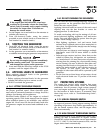
8 Generac
®
Power Systems, Inc.
Section 2 – Operation
QUIETPACT™ 65D Recreational Vehicle Generator
2.3.2 ENGINE LUBRICATION
Before starting the engine, have the engine crankcase
properly serviced with the recommended oil. Refer to
Section 1.5.3 (Page 6) and Sections 3.1 and 3.2 (Page
12) for oil servicing procedures and recommenda-
tions.
Any attempt to crank or start the engine before
you have properly serviced it with the recom-
mended oil may result in an engine failure.
2.3.3 FUEL SUPPLY
The engine must have an adequate supply of proper
fuel to operate. Before starting it, check that sufficient
fuel is available.
NOTE:
Depending on the installation, the generator may
have either a separate fuel tank or “share” the
vehicle’s engine fuel tank.
Some installations using a “shared” fuel tank may
have a generator fuel pickup tube that is shorter
than the vehicle’s engine pickup tube. Such an
arrangement causes the generator engine to “run
out of fuel”, while adequate fuel for the vehicle
engine remains in the tank.
2.3.4 COOLANT LEVEL
Check the engine coolant level prior to initial use and
at recommended intervals. Refer to Section 1.5.4,
“Coolant” (Page 6), and Section 3.8, “Engine Coolant”
(Page 14), for procedures and recommendations.
2.3.5 COOLING AND VENTILATING AIR
Air inlet and outlet openings in the generator com-
partment must be open and unobstructed for con-
tinued proper operation. Without sufficient cooling
and ventilating airflow, the engine/generator may
overheat, causing engine shutdown and damage to
the generator.
2.3.6 ENGINE EXHAUST GAS
Before starting the generator engine, you should be
sure there is no way for exhaust gases to enter the
vehicle interior and endanger people or animals.
Close windows, doors, and other openings in the
vehicle that, if open, might permit exhaust gases to
enter the vehicle.
The generator engine releases DEADLY carbon
monoxide gas through its exhaust system. This
dangerous gas, if breathed in sufficient concen-
trations, can cause unconsciousness or even
death. Never operate the generator set with
the vehicle inside any garage or other enclosed
area. DO NOT OPERATE THE GENERATOR IF THE
EXHAUST SYSTEM IS LEAKING OR HAS BEEN
DAMAGED. SYMPTOMS OF CARBON MONOX-
IDE POISONING ARE (a) inability to think coher-
ently, (b) vomiting, (c) twitching muscles, (d)
throbbing temples, (e) dizziness, (f) headaches,
(g) weakness, and (h) sleepiness. IF YOU FEEL
ANY OF THESE SYMPTOMS, MOVE INTO FRESH
AIR IMMEDIATELY. IF SYMPTOMS PERSIST, GET
MEDICAL HELP.
2.4 STARTING THE GENERATOR
NOTE:
Read the vehicle manufacturer’s instructions. The
owner/operator should become familiar with the
vehicle in which this generator is installed.
Differences exist between vehicles. For example,
some vehicles may use a transfer switch to isolate
dockside power from the generator, while other
vehicles may use an isolating receptacle. Some
vehicles may be equipped with a DC converter,
which allows the generator to power certain DC
lighting and other DC loads.
To start the generator from either the generator con-
trol panel or from the optional remote panel, proceed
as follows:
1. Turn OFF electrical loads using the means pro-
vided in your vehicle (such as, a main-line circuit
breaker or transfer switch).
NOTE:
If starting from the generator control panel, turn
OFF loads by setting the generator’s main-line
breaker to the OFF (or open) position. If starting
from a remote panel, turn OFF loads using the
means provided in the vehicle (such as, a main
circuit breaker). Electrical load circuits will be
turned ON, after the generator has started, stabi-
lized, and warmed up.
2. If the engine is cold, press the Preheat switch for
a maximum of 15 to 30 seconds.
3. While pressing the Preheat switch to crank the
engine, hold the engine Start/Stop switch in the
START position. When the engine starts, release
the switches.
◆
◆
◆
◆
◆


















